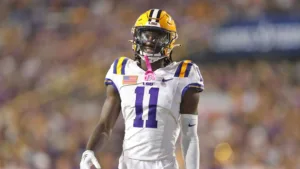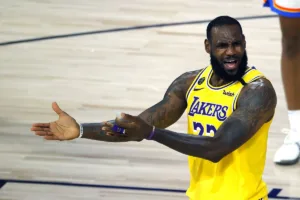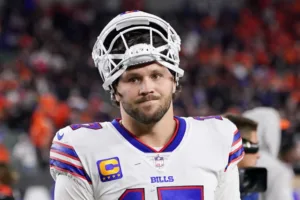Winning the Heisman Trophy is the best individual achievement a player can earn at the college football level. The best college players of all time have won this award; Tim Tebow, Johnny Manziel, Joe Burrow, Reggie Bush, the list goes on. Winning this trophy gives a college player immediate fame, becoming a household name and cementing them in college football history forever. Winning this trophy can bring eyes to a player and boost their draft stock as we see in this year’s draft with Jayden Daniels. Even though being the best college football player of the year is the highest honor the NCAA can give, do the recipients of this trophy keep playing at the same level in the NFL? The answer may be surprising for some.
The Heisman Trophy has been the crowning jewel for every college football player since 1935 when it was originally called the “Downtown Athletic Club” award. Fast forward 89 years later, and the award has become bigger than ever. People who do not watch CFB compare this award to the MVP award that is given to the “Most Valuable Player” of the NFL, but this is not a fair comparison. There are 133 FBS teams and 15,167 FBS players at the Division I level. With 68 Power 5 teams (5 biggest conferences), earning the trophy will be much harder for a player who does not have the platform that other players do, as well as the competition. There has only been 1 player who won the award that was not on a winning and competitive team, that being Paul Hornung of Notre Dame who won it in 1956. Since there are so many players and only 1 trophy, some players elect to focus on other goals. There are TWO types of players in CFB, the player who focuses on developing and using it as a step to get to the next level and the player who plays to make a legacy for himself. If we look at Tim Tebow, widely regarded as one of the best CFB players in the 2010s, he had an awful NFL career. His lefty throwing motion, mechanics, running ability, processing of coverages, and play style were most suited for CFB. This caused confusion amongst NFL fans who looked purely at his stats and record, assuming he would transition smoothly into the NFL. Another reason why Tebow did not work out as well in the NFL was the scheme he went to. His unorthodox running style combined with his half field reads were quickly shut down by opposing defenses in the pros. Tebow Time came to an end as quickly as it happened. This has become the norm for a lot of the recent Heisman winners. In the last 20 years, only 4 Heisman winners have amounted to their potential in the NFL; Cam Newton (2010), Derrick Henry (2015), Lamar Jackson (2016), and Joe Burrow (2019). There can even be arguments about Cam Newton not belonging in the same tier as the other three guys due to longevity, but for the sake of the argument we will include him. This means that 20% of the Heisman winners from the last 20 years have had their talents translate to the NFL just as well as they did in college. Factor in that 84% of the last 20 Heisman winning players were taken in the 1st round, this is a poor ratio of players that work out in the NFL.
LSU has produced 2 of the last 5 Heisman winning players, Joe Burrow and Jayden Daniels. Many have regarded LSU to be the best place for a player to develop and get to the next level, with many high pick draft prospects coming out of LSU in recent years. Names such as Justin Jefferson, Ja’Maar Chase, Derek Stingley Jr. and Devin White have all been taken early and performed well just in the last 5 years. The issue with evaluating is that every prospect is different. They have different playstyles, mechanics, personalities, IQ, bodies, and goals. An NFL fan who does not know any better may compare Joe Burrow to Jayden Daniels just by looking at simple statistics; stats, position, and a Heisman trophy. If you truly watch both of these players, you will find they are complete opposites. Joe Burrow had a very quick release with pinpoint accuracy, while reading how the defense adjusts post snap. LSU also adjusted their playbook, being under center only 3% of the time. Combine that with LSU increasing horizontal schemed routes (slants, in-breakers, and crossers), and his 88.5% Adjusted Completion% becomes more understandable. According to PFF, his offense went from 300 to 89 dropbacks with 6 or more blockers in pass protection. This allowed Burrow to run this spread offense as quickly and efficiently as possible since there was another eligible receiver on the field. What made him a player who could translate to the NFL though, was his 142.5 passer rating when throwing to a receiver who was not his first read while being 14% MORE accurate than the next QB closest to him in this category. The most important stat for him was his 15:1 TD-INT ratio when under pressure! He was better under pressure than most QBs were in a clean pocket, and this was what sold teams on his ability to play in the NFL, not his general stats or trophies. If we compare this to Jayden Daniels, most teams will look away in fear. Daniels had a pressure-to-sack% of 30.8% in 2022 and 20.2% in 2023, while playing with future OT1 (2025) Will Campbell and OT2 Emory Jones (2026). With a 26% non-blitz pressure-to-sack%, 14.1% scramble rate, and 66 sacks in 2 years, Jayden Daniels and Joe Burrow could not be more different. Jayden Daniels scheme consisted of mostly vertical routes while he read the leverage of the safeties. Despite this, he would only throw the football to a receiver if he was wide open, taking great care not to put the football in harm’s way. He was able to do this because of his exceptional rushing ability past the LOS. He has the best vision and agility out of any QB coming out of college, and this keeps defenses honest. If a defense has to have a QB spy, deep DB’s, while rushing 4 players with the best OT combination in football, they are bound to make mistakes and Jayden Daniels took what the defense gave him.
However, none of his heroics will directly translate to the NFL the same way Burrows did. Whereas Burrow could enter an NFL system and rely on his pocket presence, quick release, and post-snap processing to accurately complete passes, Jayden Daniels will enter an NFL scheme that will have to work around his slow post-snap processing and his habit to quickly leave the pocket if his 1st read is not available. This is why Justin Fields does not have a starting job, and NFL fans will slowly realize that it takes more than talent, CFB stats, and trophies to perform well in the NFL. Yearly, we see players drafted day 2 and day 3 that unlock their potential in the pros instead of college, and that allows them to reach their prime in the league instead of college. 11% of Heisman winning players have made it to the Hall of Fame. Only two players (Cam Newton and Lamar Jackson) have won both a Heisman Trophy and an MVP in the last 25 years. Only 1 player, Marcus Allen, has won a Heisman Trophy and a Super Bowl MVP EVER. While winning the Heisman is the greatest honor an individual player can receive before they reach the NFL, it almost never equals a great career in the NFL.
Photo Creds: New York Times
Follow me on instagram @thesbsports






